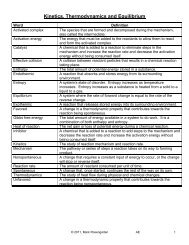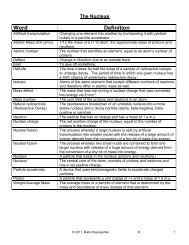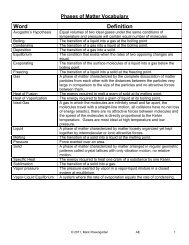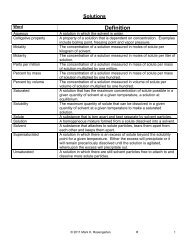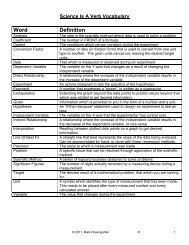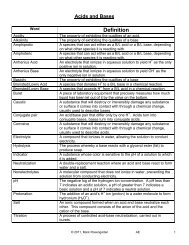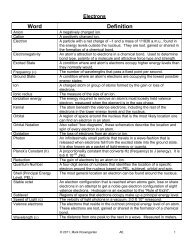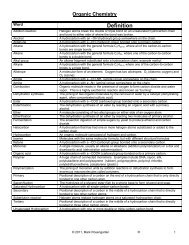Unit 5 - Mark Rosengarten
Unit 5 - Mark Rosengarten
Unit 5 - Mark Rosengarten
Create successful ePaper yourself
Turn your PDF publications into a flip-book with our unique Google optimized e-Paper software.
SUBATOMIC PARTICLES IN IONS<br />
When an atom becomes an ion, only the number of ELECTRONS changes. The number of protons is still the<br />
atomic number, and the number of electrons is still the mass number minus the atomic number.<br />
How many protons, neutrons and electrons are there in a 20 41 Ca +2 ion?<br />
- The atomic number is 20, so there are 20 protons.<br />
- The mass number is 41, so there are (41-20) = 21 neutrons.<br />
- The ion charge is +2, which means the Ca lost 2 electrons. Since the atomic number is 20, the atom started out with<br />
20 electrons. Losing two electrons brings the total down to 18 electrons.<br />
How many protons, neutrons and electrons are there in a 17 35 Cl -1 ion?<br />
- The atomic number is 17, so there are 17 protons.<br />
- The mass number is 35, so there are (35-17) = 18 neutrons.<br />
- The ion charge is -1, which means the Cl gained 1 electron. Since the atomic number is 17, the atom started out with<br />
17 electrons. Gaining one electrons brings the total up to 18 electrons.<br />
NAMING IONS<br />
Positive Ions (metals):<br />
Only ONE positive charge listed: The ion name is the same as the name of the element.<br />
Examples: Na +1 is sodium, Cd +2 is cadmium, Sr +2 is strontium and H +1 is hydrogen.<br />
TWO OR MORE positive charges listed: Put the charge after the ion name, as Roman numerals, in<br />
parentheses.<br />
Examples: Cu has 2 charges listed, +1 and +2. Cu +1 is called copper (I) and Cu +2 is copper (II).<br />
Negative Ions (nonmetals):<br />
Mn has four charges listed, +2, +3, +4 and +7. Mn +2 is manganese (II),<br />
Mn +3 is manganese (III), Mn +4 is manganese (IV) and Mn +7 is manganese (VII).<br />
The ion charge is the first one listed. Ignore all of the other charges. The name of the ion is the first syllable of the<br />
element name with the suffix –ide.<br />
Examples:<br />
Cl is chlorine. Cl -1 is chloride.<br />
O is oxygen. O -2 is oxide.<br />
C is carbon. C -4 is carbide.<br />
© 2011, <strong>Mark</strong> <strong>Rosengarten</strong> R 20



